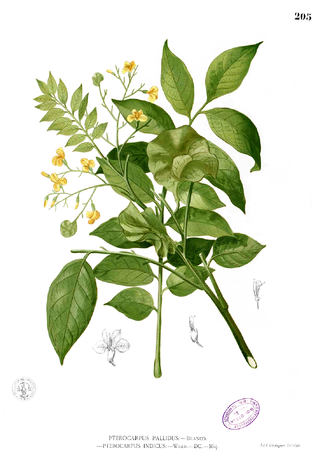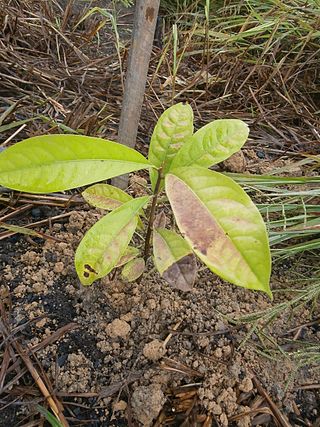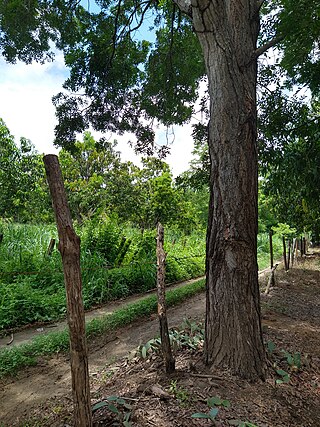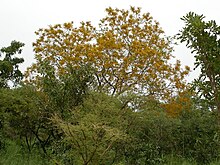
Pterocarpus is a pantropical tree genus in the Fabaceae family. It belongs to the subfamily Faboideae, and was recently assigned to the informal monophyletic Pterocarpus clade within the Dalbergieae. Most species of Pterocarpus yield valuable timber traded as padauk, usually pronounced or ; other common names are mukwa or narra.

Brachystegia spiciformis, commonly known as zebrawood, or msasa, is a medium-sized African tree having compound leaves and racemes of small fragrant green flowers. The tree is broad and has a distinctive amber and wine red colour when the young leaves sprout during spring (August–September). It grows in savanna, both open woodland and closed woodland of Southern and Eastern Africa, mostly Tanzania, Zambia, Zimbabwe, Malawi and Mozambique. The word msasa is commonly used as a proper name in African place names. The word also means 'rough plant' in Swahili. Other common names: mundu, myombo, mtondo (Tanzania), muputu (Zambia). The plant is known in the Venda language as mutsiwa, which means 'the one that is left behind'. An outlying population of Brachystegia has recently been discovered in the Soutpansberg mountains of northern South Africa. This tree is a protected species in South Africa.

Pterocarpus indicus is a species of Pterocarpus native to southeastern Asia, northern Australasia, and the western Pacific Ocean islands, in Cambodia, southernmost China, East Timor, Indonesia, Malaysia, Papua New Guinea, the Philippines, the Ryukyu Islands, the Solomon Islands, Thailand, and Vietnam.

Tetraclinis is a genus of evergreen coniferous trees in the cypress family Cupressaceae, containing only one species, Tetraclinis articulata, also known as Thuja articulata, sandarac, sandarac tree or Barbary thuja, endemic to the western Mediterranean region.

Rosewood is any of a number of richly hued hardwoods, often brownish with darker veining, but found in other colours. It is hard, tough, strong, and dense. True rosewoods come from trees of the genus Dalbergia, but other woods are often called rosewood. Rosewood takes a high polish and is used for luxury furniture-making, flooring, musical instruments, and turnery.

Leucaena leucocephala is a small fast-growing mimosoid tree native to southern Mexico and northern Central America and is now naturalized throughout the tropics including parts of Asia.

Vachellia tortilis, widely known as Acacia tortilis but now attributed to the genus Vachellia, is the umbrella thorn acacia, also known as umbrella thorn and Israeli babool, a medium to large canopied tree native to most of Africa, primarily to the savanna and Sahel of Africa, but also occurring in the Middle East.

Bloodwood is a common name for several unrelated trees, including:

Pterocarpus angolensis is a species of Pterocarpus native to southern Africa, in Angola, Mozambique, Namibia, South Africa, Eswatini, Tanzania, Democratic Republic of the Congo, Zimbabwe, and Zambia. It is a protected tree in South Africa. The name Kiaat, although Afrikaans, is sometimes used outside South Africa as well. In Zimbabwe, depending on what region you are in, it is known as Mukwa( which it is also called in Zambia) or Mubvamaropa.

Acacia salicina is a thornless species of Acacia native to Australia. It is a large shrub or small evergreen tree growing up to 13.7 m tall. It is a fast grower, dropping lots of leaf litter, with a life span of about 10–50 years. In its native range, A. salicina flowers from February to June. In the Northern Hemisphere, A. salicina flowers primarily from October to January and the seed pods are often visible from April to July. The tree's seeds are shiny, black and have a crimson appendage-like aril. A. salicina is "closely related" to Acacia ligulata and Acacia bivenosa.

Acacia confusa is a perennial tree native to South-East Asia. Some common names for it are ayangile, small Philippine acacia, Formosa acacia, Philippine Wattle, and Formosan koa. It grows to a height of 15 m. The tree has become very common in many tropical Pacific areas, including Hawaii, where the species is considered invasive.

Pterocarpus santalinus, with the common names red sanders, red saunders, Yerra Chandanam, Chenchandanam, red sandalwood, Rakta Chandana, and rakto chandon, is a species of Pterocarpus endemic to the southern Eastern Ghats mountain range of South India. This tree is valued for the rich red colour of its wood, and in recent years there has been a marked uptick in the use of red sandalwood as a component of incense, especially in the west. The tree is not to be confused with the aromatic Santalum sandalwood trees that grow natively in Southern India.

The legume Sesbania bispinosa, also known as Sesbania aculeata (Willd.) Pers., is a small tree in the genus Sesbania.
Dalbergia baronii is a species of flowering plant in the legume family Fabaceae. It is endemic to Madagascar. It is named after the English missionary and botanist Rev. Richard Baron.
Dalbergia monticola is a species of flowering plant in the legume family Fabaceae. It is endemic to Madagascar. It occurs at higher elevation, which gave the species its name.

Aniba rosaeodora, also known as pau-rosa, is a species of Magnoliid tree in the family Lauraceae. Often confused as rosewood, the plant doesn't grow on any tree of the genus Dalbergia. It grows in parts of the tropical rainforest of South America. It is an endangered species that is exploited due to its essential oil.
Mammillaria herrerae is a species of plant in the family Cactaceae. It is endemic to Mexico where it is confined to Querétaro. It thrives in a semi-desert shrubland habitat. Common name is golf ball cactus. It is threatened by habitat loss and illegal collection. In a 20-year period over 95% of the species population was illegally collected or sold. Mammillaria herrerae has an IUCN rating of critically endangered. Due to its specific growing conditions, there is a challenge in propagating. Many studies are being done to determine best growing conditions, through related species.

Swietenia humilis is a species of tree in the family Meliaceae. It is one of three species in the genus Swietenia, all three of which are regarded as "genuine mahogany." At 6 metres (20 ft), it is one-fifth the height of S. mahagoni and one-sixth the height of S. macrophylla. Its species name, humilis, means "small" or "dwarfish".

Kino is a botanical gum produced by various trees and other plants, particularly bloodwood species of eucalypts and Pterocarpus, in reaction to mechanical damage, and which can be tapped by incisions made in the trunk or stalk. Many Eucalyptus, Angophora and Corymbia species are commonly referred to as 'bloodwoods', as the kino usually oozes out a very dark red colour. Kino flow in angiosperms contrasts with resin flow in conifers. The word kino is of Indian origin. In Australia, "red gum" is a term for kino from bloodwood trees and red acaroid resin from Xanthorrhoea spp.

Encephalartos lanatus is a species of cycad, a plant belonging to the family Zamiaceae growing in Mpumalanga, South Africa. Its specific epithet, lanatus, means wooly in Latin.


















